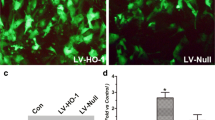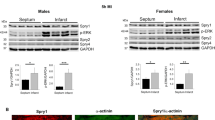Abstract
The purpose of this study was to investigate the role of myofibrillogenesis regulator-1 (MR-1) in cardiomyocyte apoptosis induced by hypoxia/reoxygenation (H/R), through protein kinase R-like ER kinase (PERK)/nuclear factor erythroid 2-related factor 2 (Nrf2) pathway. To address this aim, an H/R model of neonatal rat cardiomyocytes was used. MR-1 was overexpressed using an adenoviral vector system and knocked down using MR-1 specific siRNA. Apoptosis was assessed by using Annexin V/PI double staining, terminal deoxynucleotidyl transferase mediated dUTP-biotin nick end labeling assay, and the Bcl-2/Bax ratio. Western blotting was used to detect the protein levels of MR-1, glucose-regulated protein 78 (GRP78), total and phosphorylated PERK, Nrf2, activating transcription factor 4 (ATF4), C/EBP homologous protein (CHOP), Bcl-2 and Bax. Immunofluorescence staining was used to assess the subcellular location of Nrf2. We found that H/R induced significant apoptosis in neonatal rat cardiomyocytes. MR-1 overexpression attenuated H/R-induced apoptosis, decreased GRP78 (P < 0.01) and CHOP expression (P < 0.05), and increased the Bcl-2/Bax ratio (P < 0.01). MR-1 overexpression suppressed H/R-induced PERK phosphorylation, Nrf2 nuclear translocation, and ATF4 expression (P < 0.01). While MR-1 knockdown aggravated H/R-induced apoptosis, increased expression of GRP78 and CHOP (P < 0.05), and decreased the Bcl-2/Bax ratio (P < 0.01). MR-1 knockdown significantly increased H/R-induced PERK phosphorylation (P < 0.05), Nrf2 nuclear translocation, and ATF4 expression (P < 0.01). These findings suggest that MR-1 alleviates H/R-induced cardiomyocyte apoptosis through inhibition of the PERK/Nrf2 pathway.








Similar content being viewed by others
References
Arjmand Shabestari A (2013) Coronary artery calcium score: a review. Iran Red Crescent Med J 15:e16616
Braunwald E, Kloner RA (1985) Myocardial reperfusion: a double-edged sword? J Clin Invest 76:1713–1719
Li TB, Liu XH, Feng S et al (2004) Characterization of MR-1, a novel myofibrillogenesis regulator in human muscle. Acta Biochim Biophys Sin 36:412–418
Wang X, Tao T, Ding R et al (2014) Kidney protection against ischemia/reperfusion injury by myofibrillogenesis regulator-1. Am J Nephrol 39:279–287
Kim EM, Shin EJ, Choi JH et al (2010) Matrix metalloproteinase-3 is increased and participates in neuronal apoptotic signaling downstream of caspase-12 during endoplasmic reticulum stress. J Biol Chem 285:16444–16452
Hetz C (2012) The unfolded protein response: controlling cell fate decisions under ER stress and beyond. Nat Rev Mol Cell Biol 13:89–102
Wu XD, Zhang ZY, Sun S et al (2013) Hypoxic preconditioning protects microvascular endothelial cells against hypoxia/reoxygenation injury by attenuating endoplasmic reticulum stress. Apoptosis 18:85–98
Pahl HL (1999) Signal transduction from the endoplasmic reticulum to the cell nucleus. Physiol Rev 79:683–701
Wang C, Li YZ, Wang XR, Lu ZR, Shi DZ, Liu XH (2012) Panax quinquefolium saponins reduce myocardial hypoxia-reoxygenation injury by inhibiting excessive endoplasmic reticulum stress. Shock 37:228–233
Leonard MO, Kieran NE, Howell K et al (2006) Reoxygenation-specific activation of the antioxidant transcription factor Nrf2 mediates cytoprotective gene expression in ischemia-reperfusion injury. FASEB J 20:2624–2626
Miyamoto N, Izumi H, Miyamoto R et al (2011) Transcriptional regulation of activating transcription factor 4 under oxidative stress in retinal pigment epithelial ARPE-19/HPV-16 cells. Invest Ophthalmol Vis Sci 52:1226–1234
Wang X, Liu X, Wang S, Luan K (2012) Myofibrillogenesis regulator 1 induces hypertrophy by promoting sarcomere organization in neonatal rat cardiomyocytes. Hypertens Res 35:597–603
Liu X, Wu X, Cai L, Tang C, Su J (2003) Hypoxic preconditioning of cardiomyocytes and cardioprotection: phophorylation of HIF-1alpha induced by p42/p44 mitogen-activated protein kinases is involved. Pathophysiology 9:201–205
Li Y, Ge X, Liu X (2009) The cardioprotective effect of postconditioning is mediated by ARC through inhibiting mitochondrial apoptotic pathway. Apoptosis 14:164–172
Gottlieb RA, Burleson KO, Kloner RA, Babior BM, Engler RL (1994) Reperfusion injury induces apoptosis in rabbit cardiomyocytes. J Clin Invest 94:1621–1628
Yamashita N, Nishida M, Hoshida S et al (1994) Induction of manganese superoxide dismutase in rat cardiac myocytes increases tolerance to hypoxia 24 hours after preconditioning. J Clin Invest 94:2193–2199
Liu X, Li T, Sun S, Xu F, Wang Y (2006) Role of myofibrillogenesis regulator-1 in myocardial hypertrophy. Am J Physiol Heart Circ Physiol 290:H279–H285
Li HL, She ZG, Li TB et al (2007) Overexpression of myofibrillogenesis regulator-1 aggravates cardiac hypertrophy induced by angiotensin II in mice. Hypertension 49:1399–1408
Dai W, He W, Shang G, Jiang J, Wang Y, Kong W (2010) Gene silencing of myofibrillogenesis regulator-1 by adenovirus-delivered small interfering RNA suppresses cardiac hypertrophy induced by angiotensin II in mice. Am J Physiol Heart Circ Physiol 299:H1468–H1475
McCullough KD, Martindale JL, Klotz LO, Aw TY, Holbrook NJ (2001) Gadd153 sensitizes cells to endoplasmic reticulum stress by down-regulating Bcl2 and perturbing the cellular redox state. Mol Cell Biol 21:1249–1259
Lalier L, Cartron PF, Juin P et al (2007) Bax activation and mitochondrial insertion during apoptosis. Apoptosis 12:887–896
Wang M, Meng XB, Yu YL et al (2014) Elatoside C protects against hypoxia/reoxygenation-induced apoptosis in H9c2 cardiomyocytes through the reduction of endoplasmic reticulum stress partially depending on STAT3 activation. Apoptosis 19:1727–1735
Thuerauf DJ, Marcinko M, Gude N et al (2006) Activation of the unfolded protein response in infarcted mouse heart and hypoxic cultured cardiac myocytes. Circ Res 99:275–282
Lu F, Tian Z, Zhang W et al (2010) Calcium-sensing receptors induce apoptosis in rat cardiomyocytes via the endo (sarco) plasmic reticulum pathway during hypoxia/reoxygenation. Basic Clin Pharmacol Toxicol 106:396–405
Roybal CN, Marmorstein LY, Vander Jagt DL, Abcouwer SF (2005) Aberrant accumulation of fibulin-3 in the endoplasmic reticulum leads to activation of the unfolded protein response and VEGF expression. Invest Ophthalmol Vis Sci 46:3973–3979
Narjoz C, Marisa L, Imbeaud S et al (2009) Genomic consequences of cytochrome P450 2C9 overexpression in human hepatoma cells. Chem Res Toxicol 22:779–787
Inberg A, Linial M (2010) Protection of pancreatic beta-cells from various stress conditions is mediated by DJ-1. J Biol Chem 285:25686–25698
Reuland DJ, Khademi S, Castle CJ et al (2013) Upregulation of phase II enzymes through phytochemical activation of Nrf2 protects cardiomyocytes against oxidant stress. Free Radic Biol Med 56:102–111
He X, Kan H, Cai L, Ma Q (2009) Nrf2 is critical in defense against high glucose-induced oxidative damage in cardiomyocytes. J Mol Cell Cardiol 46:47–58
Ichikawa T, Li J, Meyer CJ, Janicki JS, Hannink M, Cui T (2009) Dihydro-CDDO-trifluoroethyl amide (dh404), a novel Nrf2 activator, suppresses oxidative stress in cardiomyocytes. PLoS ONE 4:e8391
Huang XS, Chen HP, Yu HH, Yan YF, Liao ZP, Huang QR (2014) Nrf2-dependent upregulation of antioxidative enzymes: a novel pathway for hypoxic preconditioning-mediated delayed cardioprotection. Mol Cell Biochem 385:33–41
Afonyushkin T, Oskolkova OV, Philippova M et al (2010) Oxidized phospholipids regulate expression of ATF4 and VEGF in endothelial cells via NRF2-dependent mechanism: novel point of convergence between electrophilic and unfolded protein stress pathways. Arterioscler Thromb Vasc Biol 30:1007–1013
Du P, Saidu NE, Intemann J, Jacob C, Montenarh M (2014) A new tellurium-containing amphiphilic molecule induces apoptosis in HCT116 colon cancer cells. Biochim Biophys Acta 1840:1808–1816
He CH, Gong P, Hu B et al (2001) Identification of activating transcription factor 4 (ATF4) as an Nrf2-interacting protein. Implication for heme oxygenase-1 gene regulation. J Biol Chem 276:20858–20865
Cullinan SB, Diehl JA (2004) PERK-dependent activation of Nrf2 contributes to redox homeostasis and cell survival following endoplasmic reticulum stress. J Biol Chem 279:20108–20117
Zong ZH, Du ZX, Li N et al (2012) Implication of Nrf2 and ATF4 in differential induction of CHOP by proteasome inhibition in thyroid cancer cells. Biochim Biophys Acta 1823:1395–1404
Acknowledgments
This work was supported by Grants from National Natural Science Foundation of China 31471094 (XH Liu) and 81170140 (XH Liu).
Author information
Authors and Affiliations
Corresponding author
Rights and permissions
About this article
Cite this article
Tao, TQ., Wang, XR., Liu, M. et al. Myofibrillogenesis regulator-1 attenuated hypoxia/reoxygenation-induced apoptosis by inhibiting the PERK/Nrf2 pathway in neonatal rat cardiomyocytes. Apoptosis 20, 285–297 (2015). https://doi.org/10.1007/s10495-014-1081-1
Published:
Issue Date:
DOI: https://doi.org/10.1007/s10495-014-1081-1




